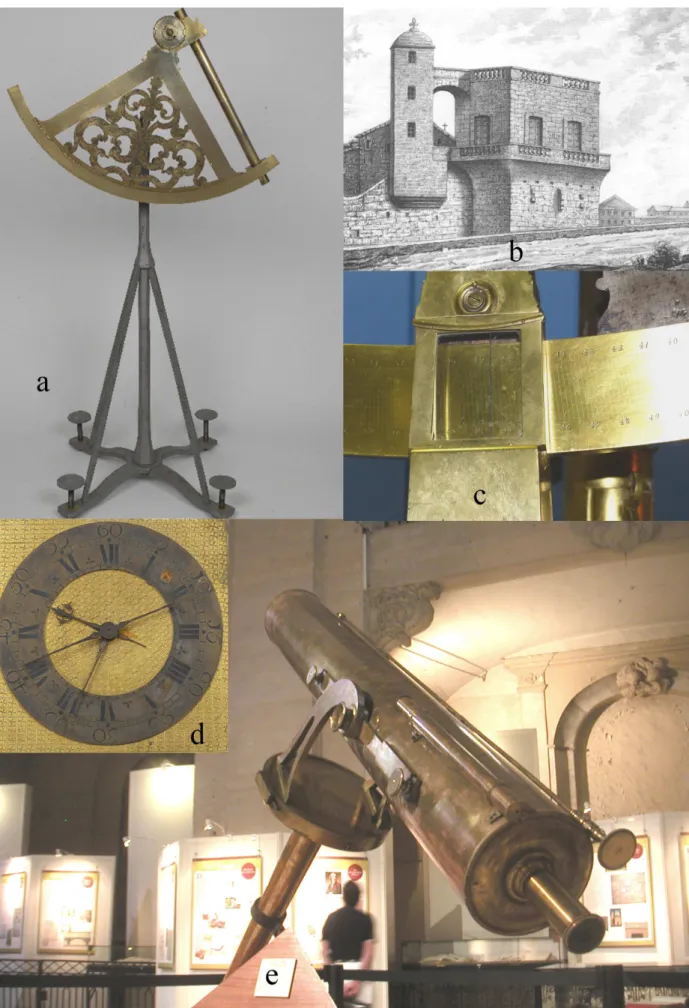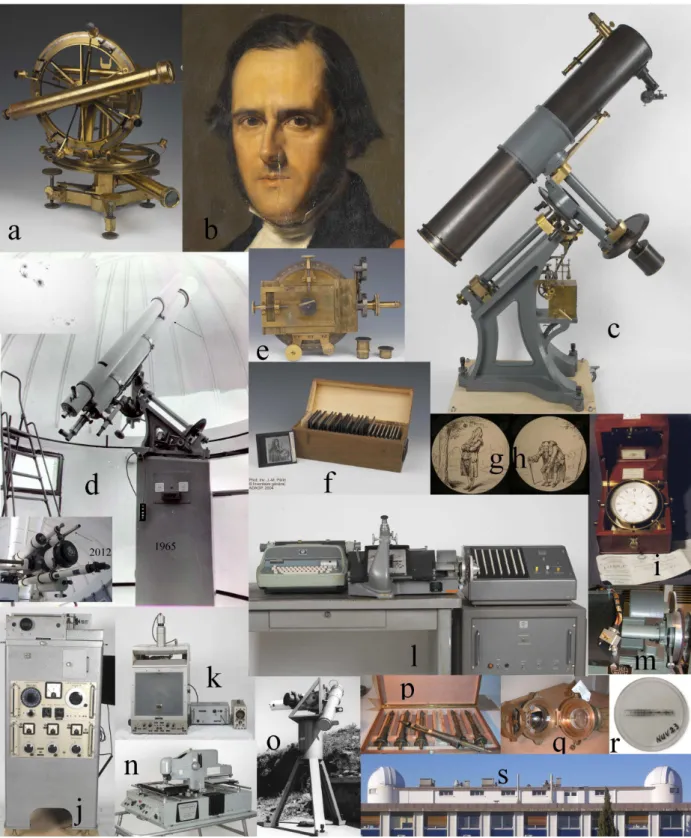HAL Id: hal-02009797
https://hal.archives-ouvertes.fr/hal-02009797
Submitted on 6 Feb 2019
HAL is a multi-disciplinary open access
archive for the deposit and dissemination of
sci-entific research documents, whether they are
pub-lished or not. The documents may come from
teaching and research institutions in France or
abroad, or from public or private research centers.
L’archive ouverte pluridisciplinaire HAL, est
destinée au dépôt et à la diffusion de documents
scientifiques de niveau recherche, publiés ou non,
émanant des établissements d’enseignement et de
recherche français ou étrangers, des laboratoires
publics ou privés.
DE ASTRONOMICIS INSTRUMENTIS IN
UNIVERSITATE MONSPELIENSI
H. Reboul
To cite this version:
H. Reboul. DE ASTRONOMICIS INSTRUMENTIS IN UNIVERSITATE MONSPELIENSI. SF2A
2013, Jun 2013, Montpellier, France. �hal-02009797�
DE ASTRONOMICIS INSTRUMENTIS IN UNIVERSITATE MONSPELIENSI
H. Reboul
1Abstract. Montpellier hosted one of the first French observatories, and has therefore a long and rich tradition in the development of astronomy as a research topic or as a teaching subject since the 17th
century. This is the reason why such a large collection of astronomical instruments could be gathered and preserved. Recently, the Science university of Montpellier has worked towards the inclusion of this collection on the French National Heritage List (at least for 56 items out of the 240 listed in the inventory), and some of them have been repaired. You will find below the history of this collection which can be accessed online.
Keywords: history, instrumentation, telescopes
1 Introduction During the 17th
century, many scientific societies were created in Languedoc. Both the instruments and the rare books collections preserved by the universities of Montpellier bring a testimony of a long tradition of astronomical observations and teaching. The historical content inside this short review is mainly founded on the following works: Roche (1881); Dulieu (1981); Faidit (1986, 1993, 2001, 2007).
2 The Observatory of the Babote Tower in the 18th
century
The ‘Soci´et´e Royale des Sciences de Montpellier’ was officially founded in February 1706 in close alliance with the ‘Parisian Acad´emie des Sciences’∗.
On the 12th
May 1706, the academicians used telescopes fastened on masts to make a detailed observation of the total eclipse of the sun; the accounts of this occurrence were published in the Society’s Proceedings.
The Assembly of the Languedoc contributed to this scientific progress, and gave their sponsorship by paying for the building of the observatory in the Babote Tower (Fig. 1 b) which began to be used in 1745. They also helped the astronomers by buying them an 8-inches Nairne Gregorian telescope in 1784. The scientific works of the astronomers during that period were manifold, focusing on all the usual astronomical topics, but also on the major map-making enterprise at the end of the 18th
century in Languedoc. 3 Research and teaching in the 19th
century
Created in 1808, the Science Faculty appointed an astronomy professor as soon as 1810. Edouard Roche (Fig. 2 b) was a professor in the Faculty during 34 years; it is in Montpellier that he published his major works (i.e. those defining ‘Roche’s’ limits and lobes) which would however be acknowledged by the scientific community only a century later. He did a lot for the preservation and the increase of the scientific heritage of the Faculty.
1
LUPM (UMR 5299) CC 72, Universit´e Montpellier 2, Pl. E. Bataillon, 34095, MONTPELLIER Cedex 5, France
∗Both these academies were part of the same administrative body, as each one of their members were able to participate to the
others’ meetings whenever they happened to be present c
238 SF2A 2013
4 From photography to digital images in the 20th
century
Photography was the medium through which spectra and images are taken during almost a century. Both its unlinear response and one time use has led towards the invention of very complex instruments to set the standards of these pictures and to extract the astrophysical signals they register. The Montpellier Astronomy Laboratory, created in 1960 has been able to buy, use and keep these instruments and their gradual modifica-tions until the digital photography era (Fig. 2 j, k, l, m, n).
5 An ‘experiment’ in astrophysics in the ‘sixties’
The Montpellier Astronomy Laboratory has been able to keep the entirety of the scientific equipment used during its two spatial missions ‘Artificial Comet’ in 1966 and 1969. Among them are spectrographs with fast film reloading and ultra-luminous optics (F/D = 0.65) (Fig. 2 o, p, q, r).
6 Preservation and cultural heritage policy
In the sixties, some of these instruments were showcased in the corridors of the Astronomy Laboratory at the Science university. In 1999, they were shown in different exhibitions and 56 of them were listed on the National Heritage List with the help of the DRAC-LR in 2005 and 2006. Dated from 1725 to 1980, 11 of them date back to the 18th
century, 17 to the 19th
century, and 28 to the 20th
cent. The repairing of the instruments dating from the 18th and 19th
century has been paid for by the Scientific Heritage Section of the University: the inventory of the collections it preserves can be accessed online via its website at the following address:
http://www.collections.univ-montp2.fr/les-collections-de-lum2/astronomie/nosearch
Furthermore, an ‘Association des Amis des Collections Scientifiques et Techniques’ is under agreement with UM2 and its members (mainly retired scientists) give advices and expertises whenever it is needed.
Some of the items are shown for 18th
(Fig. 1) and 19th
and 20th
(Fig. 2) centuries. 7 Conclusions
An important part of the 18th
-century Montpellier Observatory heritage could be transmitted to the Science Faculty. The continuity of the astronomical work of the Faculty has made possible the preservation of most of the major instruments that were used throughout this period. The Science University’s undertaking of a heritage preservation policy has made possible the collecting of almost 240 items, among which 56 are now listed on the National Heritage List. It remains now to be found a place where they could be studied and admired more widely.
Many thanks to Elizabeth Denton, curator of the rare books department in the Science university library for fruitful exchanges on the context of that work and for many improvements of this paper.
References
RocheE., 1881, ‘Notice sur l’Observatoire de l’ancienne soci´et´e des sciences de Montpellier’, M´emoires de l’Acad´emie des Sciences de Montpellier
Dulieu, L., 1981 ‘La facult´e des Sciences de Montpellier’ Presses universelles Faidit, J.-M., 1986, ‘L’Observatoire de la Babote’, ISBN 2-9501264-0-5
Faidit, J.-M., 1993, ‘Les ‘amateurs de sciences’ d’une province et le ciel au XVIIIe si`ecle : Astronomie et Astronomes en Languedoc : approche d’histoire des sciences’. Th`ese de l’universit´e Montpellier III
Faidit, J.-M., 2001, ‘Le pavillon d’astronomie du jardin des plantes’ , ISBN 2-9516194-0-5 Faidit, J.-M., 2007, ‘Limites et lobes de Roche’, ISBN 978-2-7117-4017-8
Fig. 1. 18th
cent. : a) Quadrant by Cadot, Paris, 1730. b) Babote Montpellier Observatory (before the building of the second floor in 1788). c) detail of 2 feet quadrant by Langlois, Paris, 1736. d) Clock by Le Roy,Paris circa 1740.e) Gregorian telescope by Nairne, London, 1770 (as shown in 2007 before its repair).
240 SF2A 2013
Fig. 2. 19th
and 20th
cent. : a) Theodolite by Gambey, Paris, 1826. b) Edouard-Albert Roche, painting by Matet, 1867. c) Foucault Telescope by Eichens, Paris, 1877. d) Eichens 160 mm refracting telescope through the centuries : constructed by Eichens in 1873, the main picture shows its re-installation at present OUM2 (Observatoire de l’ Universit´e Montpellier 2) in 1964 on the new campus of Science Faculty and insets display, in 2012, its position and sunspots obtained through its lens. e) Micrometric ocular of Eichens refracting telescope (d), 1873 . f ), g), h) Pedagogic and humoristic (g, h) slides, 1900. i) Marine chronometer by Louis Leroy, Paris, circa 1900. j) Challonge Registering microphotometer by Laffineur, 1962. k) Iris photometer by Askania, 1965. l), m) Digital microscope by Hilger & Watts, 1961, modified in 1965 at OHP (Observatoire de Haute Provence) to punch cards. n) double-beam registering microdensitometer by Joyce, Loebl & Co., circa 1967. o), p), q), r) ‘Artificial Comet’ spatial mission, telescopes, spectrographs, fast-loading film-holders, F/0.65 catadioptric objective of the nebular spectrograph, by REOSC, Paris, 1966. r) is a spectrum of Kohoutek comet on 26/11/1973 obtained with the silicium F/0.65 objective on the nebular spectrograph mounted at the Cassegrain focus of the 500 mm telescope of OUM2 (70 min exposure on 103 aO). s) general view of OUM2 in 2012.

